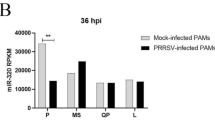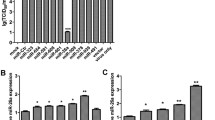Abstract
Porcine reproductive and respiratory syndrome (PRRS) is one of the most economically important diseases of swine, which is caused by PRRS virus (PRRSV). CD151, one of PRRSV entry mediators, determines the cell susceptibility for PRRSV. Emerging evidence indicates that the host microRNAs (miRNAs) play key roles in modulating virus infection and viral pathogenesis. In the present study, targeting porcine CD151 miRNAs were identified, and their function during PRRSV infection in MARC-145 cells was further verified. We found that miR-506 could directly target porcine CD151 3′-UTR mRNA by luciferase reporter assay. Overexpression of miR-506 significantly decreased CD151 expression at both mRNA and protein levels. Furthermore, overexpression of miR-506 reduced cellular PRRSV replication and virus release in MARC-145 cells. Our results suggested that miR-506 could inhibit PRRSV replication by directly targeting PRRSV receptor of CD151 in MARC-145 cells. However, the molecular mechanisms of miR-506 and its function in vivo need further investigation.



Similar content being viewed by others
References
Guo XK, Zhang Q, Gao L, Li N, Chen XX, Feng WH (2013) Increasing expression of microRNA 181 inhibits porcine reproductive and respiratory syndrome virus replication and has implications for controlling virus infection. J Virol 87:1159–1171
Kim HS, Kwang J, Yoon IJ, Joo HS, Frey ML (1993) Enhanced replication of porcine reproductive and respiratory syndrome (PRRS) virus in a homogeneous subpopulation of MA-104 cell line. Arch Virol 133:477–483
Kreutz LC, Ackermann MR (1996) Porcine reproductive and respiratory syndrome virus enters cells through a low pH-dependent endocytic pathway. Virus Res 42:137–147
Van Breedam W, Delputte PL, Van Gorp H, Misinzo G, Vanderheijden N, Duan X, Nauwynck HJ (2010) Porcine reproductive and respiratory syndrome virus entry into the porcine macrophage. J Gen Virol 91:1659–1667
Shanmukhappa K, Kim JK, Kapil S (2007) Role of CD151, A tetraspanin, in porcine reproductive and respiratory syndrome virus infection. Virol J 4:62
Lewis BP, Burge CB, Bartel DP (2005) Conserved seed pairing, often flanked by adenosines, indicates that thousands of human genes are microRNA targets. Cell 120:15–20
Huntzinger E, Izaurralde E (2011) Gene silencing by microRNAs. Contributions of translational repression and mRNA decay. Nat Rev Genet 12:99–110
Pedersen IM, Cheng G, Wieland S, Volinia S, Croce CM, Chisari FV, David M (2007) Interferon modulation of cellular microRNAs as an antiviral mechanism. Nature 449:919–922
Nathans R, Chu CY, Serquina AK, Lu CC, Cao H, Rana TM (2009) Cellular microRNA and P bodies modulate host-HIV-1 interactions. Mol Cell 34:696–709
Nachmani D, Lankry D, Wolf DG, Mandelboim O (2010) The human cytomegalovirus microRNA miR-UL112 acts synergistically with a cellular microRNA to escape immune elimination. Nat Immunol 11:806–813
Kim S, Lee S, Shin J, Kim Y, Evnouchidou I, Kim D, Kim YK, Kim YE, Ahn JH, Riddell SR, Stratikos E, Kim VN, Ahn K (2011) Human cytomegalovirus microRNA miR-US4-1 inhibits CD8(+) T cell responses by targeting the aminopeptidase ERAP1. Nat Immunol 12:984–991
Wang D, Cao L, Xu Z, Fang L, Zhong Y, Chen Q, Luo R, Chen H, Li K, Xiao S (2013) MiR-125b reduces porcine reproductive and respiratory syndrome virus replication by negatively regulating the NF-kB pathway. PLoS One 8:e55838
Gao L, Guo XK, Wang L, Zhang Q, Li N, Chen XX, Wang Y, Feng WH (2013) MicroRNA 181 suppresses porcine reproductive and respiratory syndrome virus (PRRSV) infection by targeting PRRSV receptor CD163. J Virol 87:8808–8812
Han ZB, Yang Z, Chi Y, Zhang L, Wang Y, Ji Y, Wang J, Zhao H, Han ZC (2013) MicroRNA-124 suppresses breast cancer cell growth and motility by targeting CD151. Cell Physiol Biochem 31:823–832
Arora H, Qureshi R, Park WY (2013) miR-506 regulates epithelial mesenchymal transition in breast cancer cell lines. PLoS One 8:e64273
Li B, Xiao S, Wang Y, Xu S, Jiang Y, Chen H, Fang L (2009) Immunogenicity of the highly pathogenic porcine reproductive and respiratory syndrome virus GP5 protein encoded by a synthetic ORF5 gene. Vaccine 27:1957–1963
Livak KJ, Schmittgen TD (2001) Analysis of relative gene expression data using real-time quantitative PCR and the 2(-Delta Delta C(T)) method. Methods 25:402–408
Sung TL, Rice AP (2009) miR-198 inhibits HIV-1 gene expression and replication in monocytes and its mechanism of action appears to involve repression of cyclin T1. PLoS Pathog 5:e1000263
Chiang K, Sung TL, Rice AP (2012) Regulation of cyclin T1 and HIV-1 replication by microRNAs in resting CD4+ T lymphocytes. J Virol 86:3244–3252
Lecellier CH, Dunoyer P, Arar K, Lehmann-Che J, Eyquem S, Himber C, Saib A, Voinnet O (2005) Acellular microRNA mediates antiviral defense in human cells. Science 308:557–560
Song L, Liu H, Gao S, Jiang W, Huang W (2010) Cellular microRNAs inhibit replication of the H1N1 influenza A virus in infected cells. J Virol 84:8849–8860
Zhang Q, Guo XK, Gao L, Huang C, Li N, Jia X, Liu W, Feng WH (2014) MicroRNA-23 inhibits PRRSV replication by directly targeting PRRSV RNA and possibly by upregulating type I interferons. Virology 450–451:182–195
Zijlstra A, Lewis J, Degryse B, Stuhlmann H, Quigley JP (2008) The inhibition of tumor cell intravasation and subsequent metastasis via regulation of in vivo tumor cell motility by the tetraspanin CD151. Cancer Cell 13:221–234
Kwon MJ, Park S, Choi JY, Oh E, Kim YJ, Park YH, Cho EY, Kwon MJ, Nam SJ, Im YH, Shin YK, Choi YL (2012) Clinical significance of CD151 overexpression in subtypes of invasive breast cancer. Br J Cancer 106:923–930
Copeland BT, Bowman MJ, Ashman LK (2013) Genetic ablation of the tetraspanin CD151 reduces spontaneous metastatic spread of prostate cancer in the TRAMP model. Mol Cancer Res 11:95–105
Yang D, Sun Y, Hu L, Zheng H, Ji P, Pecot CV, Zhao Y, Reynolds S, Cheng H, Rupaimoole R, Cogdell D, Nykter M, Broaddus R, Rodriguez-Aguayo C, Lopez-Berestein G, Liu J, Shmulevich I, Sood AK, Chen K, Zhang W (2013) Integrated analyses identify a master microRNA regulatory network for the mesenchymal subtype in serous ovarian cancer. Cancer Cell 23:186–199
Zhao Y, Liu H, Li Y, Wu J, Greenlee AR, Yang C, Jiang Y (2011) The role of miR-506 in transformed 16HBE cells induced by anti-benzo[a]pyrene-trans-7,8-dihydrodiol-9,10-epoxide. Toxicol Lett 205:320–326
Markova SM, Kroetz DL (2013) ABCC4 is regulated by microRNA-124a and microRNA-506. Biochem Pharmacol. doi:10.1016/j.bcp.2013.10.017
Tong JL, Zhang CP, Nie F, Xu XT, Zhu MM, Xiao SD, Ran ZH (2011) MicroRNA 506 regulates expression of PPAR alpha in hydroxycamptothecin-resistant human colon cancer cells. FEBS Lett 585:3560–3568
Acknowledgments
Financial assistance from National Science and Technology Support Project (2011BAD28B01), National Pig Industry Technology System (CARS-36), Hubei Agricultural Science and Technology Innovation Center (2011-620-001-003), Hubei Key Laboratory of Animal Embryo Engineering and Molecular Breeding (2013ZD101), Hubei Province Public Welfare Scientific Research Project (2013BBB15), Youth Foundation of Hubei Provincial Academy of Agricultural Sciences (2013NKYJJ11), and Hubei Introducing Training Programme Foundation for the Top Talents are greatly appreciated.
Author information
Authors and Affiliations
Corresponding author
Rights and permissions
About this article
Cite this article
Wu, J., Peng, X., Zhou, A. et al. MiR-506 inhibits PRRSV replication in MARC-145 cells via CD151. Mol Cell Biochem 394, 275–281 (2014). https://doi.org/10.1007/s11010-014-2103-6
Received:
Accepted:
Published:
Issue Date:
DOI: https://doi.org/10.1007/s11010-014-2103-6




